Vue lecture
Portal Space Systems announces highly maneuverable satellite bus

Portal Space Systems says it will develop a highly maneuverable satellite bus, with a first flight planned for late 2026.
The post Portal Space Systems announces highly maneuverable satellite bus appeared first on SpaceNews.
China breaks annual launch record with VLEO Chutian and Shiyan technology test launches

China conducted a pair of solid rocket launches late Saturday, seeing the country surpass its previous record for orbital launch attempts in a calendar year.
The post China breaks annual launch record with VLEO Chutian and Shiyan technology test launches appeared first on SpaceNews.
The Hidden Math of Ocean Waves

Intuitive Machines sees Lanteris deal creating new opportunities in defense and exploration

Intuitive Machines says its acquisition of satellite manufacturer Lanteris Space Systems will open new opportunities for the company, from participation in Golden Dome to developing a crewed lunar lander.
The post Intuitive Machines sees Lanteris deal creating new opportunities in defense and exploration appeared first on SpaceNews.
Blue Origin seeking exemption from FAA order restricting commercial launches

Blue Origin says it is working with the government for additional opportunities for the upcoming New Glenn launch of a NASA Mars mission, given new FAA restrictions on commercial launches.
The post Blue Origin seeking exemption from FAA order restricting commercial launches appeared first on SpaceNews.
Juvenile Fish Are Wielding Sea Anemones Like Shields Against Predators
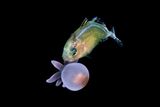
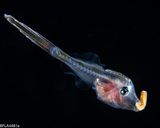

A Gene Editing Therapy Cut Cholesterol Levels by Half

Trump’s Hatred of EVs Is Making Gas Cars More Expensive

Unpicking How to Measure the Complexity of Knots

Dementia researchers cheer Texas voters’ approval of $3 billion funding initiative
Metal scaffolds turn bacteria into live wires
AST SpaceMobile sheds more light on sovereign direct-to-device plan for Europe

AST SpaceMobile has registered plans with international regulators via Germany for a sovereign, space-based network that would provide broadband directly to devices across Europe, the U.S.-based satellite operator said Nov. 7.
The post AST SpaceMobile sheds more light on sovereign direct-to-device plan for Europe appeared first on SpaceNews.
Hegseth pledges sweeping overhaul of Pentagon procurement

Shift toward ‘commercial first’ buying could benefit fast-moving space and tech firms
The post Hegseth pledges sweeping overhaul of Pentagon procurement appeared first on SpaceNews.
Is Sourdough Bread Full of Hidden Health Benefits or Is It Just a Trend?

Europe’s lead in hyperspectral Earth observation depends on public–private partnerships

For half a century, satellites have chased the same prize: ever sharper pictures of Earth. Each advance brought more pixels and greater clarity, but only in terms of how things looked. Now, a different kind of technology is emerging, one that reveals the biochemical composition of man-made and natural objects: hyperspectral imaging. By capturing hundreds […]
The post Europe’s lead in hyperspectral Earth observation depends on public–private partnerships appeared first on SpaceNews.
Is a Sun a Star or a Planet? How We Know — and What Could Change
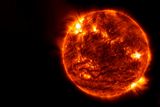
China’s Shenzhou-20 crewed spacecraft return delayed by space debris impact
China has delayed the return of a crewed mission to the country’s space station over fears that the astronaut’s spacecraft has been struck by space debris. The craft was supposed to return to Earth on 5 November but the China Manned Space Agency says it will now carry out an impact analysis and risk assessment before making any further decisions about when the astonauts will return.
The Shenzhou programme involves taking astronauts to and from China’s Tiangong space station, which was constructed in 2022, for six-month stays.
Shenzhou-20, carrying three crew, launched on 24 April from Jiuquan Satellite Launch Center on board a Long March 2F rocket. Once docked with Tiangong the three-member crew of Shenzhou-19 began handing over control of the station to the crew of Shenzhou-20 before they returned to Earth on 30 April.
The three-member crew of Shenzhou-21 launched on 31 October and underwent the same hand-over process with the crew of Shenzhou-20 before they were set to return to Earth on Wednesday.
Yet pre-operation checks revealed that the craft had been hit by “a small piece of debris” with the location and scale of the damage to Shenzhou-20 having not been released.
If the craft is deemed unsafe following the assessment, it is possible that the crew of Shenzhou-20 will return to Earth aboard Shenzhou-21. Another option is to launch a back-up Shenzhou spacecraft, which remains on stand-by and could be launched within eight days.
Space debris is of increasing concern and this marks the first time that a crewed craft has been delayed due to a potential space debris impact. In 2021, for example, China noted that Tiangong had to perform two emergency avoidance manoeuvres to avoid fragments produced by Starlink satellites that were launched by SpaceX.
- For more on the impact of space debris, sign-up for a Physics World Live event on “Space junk – and how to solve it” on 10 November at 9 p.m. GMT.
The post China’s Shenzhou-20 crewed spacecraft return delayed by space debris impact appeared first on Physics World.
Twistelastics controls how mechanical waves move in metamaterials
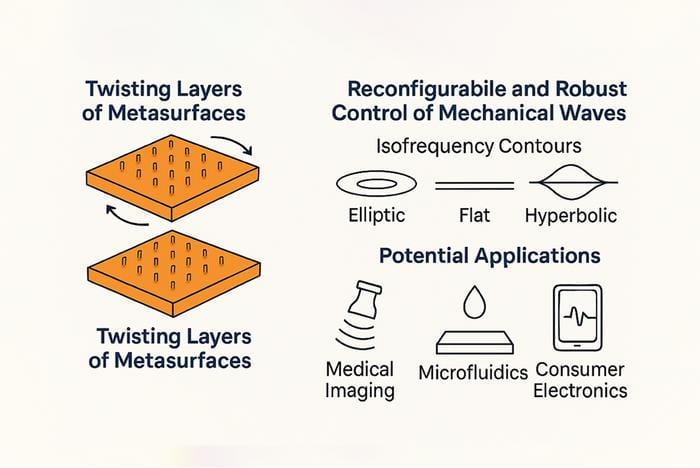
By simply placing two identical elastic metasurfaces atop each other and then rotating them relative to each other, the topology of the elastic waves dispersing through the resulting stacked structure can be changed – from elliptic to hyperbolic. This new control technique, from physicists at the CUNY Advanced Science Research Center in the US, works over a broad frequency range and has been dubbed “twistelastics”. It could allow for advanced reconfigurable phononic devices with potential applications in microelectronics, ultrasound sensing and microfluidics.
The researchers, led by Andrea Alù, say they were inspired by the recent advances in “twistronics” and its “profound impact” on electronic and photonic systems. “Our goal in this work was to explore whether similar twist-induced topological phenomena could be harnessed in elastodynamics in which phonons (vibrations of the crystal lattice) play a central role,” says Alù.
In twistelastics, the rotations between layers of identical, elastic engineered surfaces are used to manipulate how mechanical waves travel through the materials. The new approach, say the CUNY researchers, allows them to reconfigure the behaviour of these waves and precisely control them. “This opens the door to new technologies for sensing, communication and signal processing,” says Alù.
From elliptic to hyperbolic
In their work, the researchers used computer simulations to design metasurfaces patterned with micron-sized pillars. When they stacked one such metasurface atop the other and rotated them at different angles, the resulting combined structure changed the way phonons spread. Indeed, their dispersion topology went from elliptic to hyperbolic.
At a specific rotation angle, known as the “magic angle” (just like in twistronics), the waves become highly focused and begin to travel in one direction. This effect could allow for more efficient signal processing, says Alù, with the signals being easier to control over a wide range of frequencies.
The new twistelastic platform offers broadband, reconfigurable, and robust control over phonon propagation,” he tells Physics World. “This may be highly useful for a wide range of application areas, including surface acoustic wave (SAW) technologies, ultrasound imaging and sensing, microfluidic particle manipulation and on-chip phononic signal processing.
New frontiers
Since the twist-induced transitions are topologically protected, again like in twistronics, the system is resilient to fabrication imperfections, meaning it can be miniaturized and integrated into real-world devices, he adds. “We are part of an exciting science and technology centre called ‘New Frontiers of Sound’, of which I am one of the leaders. The goal of this ambitious centre is to develop new acoustic platforms for the above applications enabling disruptive advances for these technologies.”
Looking ahead, the researchers say they are looking into miniaturizing their metasurface design for integration into microelectromechanical systems (MEMS). They will also be studying multi-layer twistelastic architectures to improve how they can control wave propagation and investigating active tuning mechanisms, such as electromechanical actuation, to dynamically control twist angles. “Adding piezoelectric phenomena for further control and coupling to the electromagnetic waves,” is also on the agenda says Alù.
The present work is detailed in PNAS.
The post Twistelastics controls how mechanical waves move in metamaterials appeared first on Physics World.
Not All Food-Borne Bacteria Are Bad, Some Can Benefit Your Health — Here’s What You Should Know
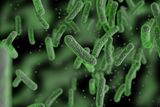
GHGSat continues to expand its methane-monitoring constellation

SAN FRANCISCO – GHGSat announced plans Nov. 7 to send two additional satellites into its greenhouse-gas-monitoring constellation. Ahead of the 30th Conference of the Parties to the United Nations Framework Convention on Climate Change in Brazil, Montreal-based GHGSat is preparing to expand its methane-monitoring constellation from 12 to 14 satellites. “With a constellation of this […]
The post GHGSat continues to expand its methane-monitoring constellation appeared first on SpaceNews.
Space is key to the Army’s long march to a connected force

The Next Generation Command and Control (NGC2) is borrowing playbooks from the commercial tech world.
The post Space is key to the Army’s long march to a connected force appeared first on SpaceNews.
FAA to restrict commercial launches during government shutdown

The Federal Aviation Administration will temporarily limit the hours that commercial space launches can take place, citing strains on the air traffic control system during the government shutdown.
The post FAA to restrict commercial launches during government shutdown appeared first on SpaceNews.
The next generation of environmental intelligence: Why high-resolution satellite imagery must power our planet’s future

Imagine trying to spot an object just 30 centimeters wide from hundreds of kilometers above Earth. Years ago, I remember when “satellite view” meant blurry green blobs on a screen. Now, we can see individual trees, cars and even shadows cast by buildings. We finally have the power to witness our planet as it truly […]
The post The next generation of environmental intelligence: Why high-resolution satellite imagery must power our planet’s future appeared first on SpaceNews.